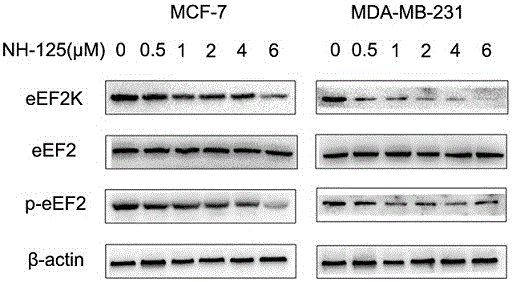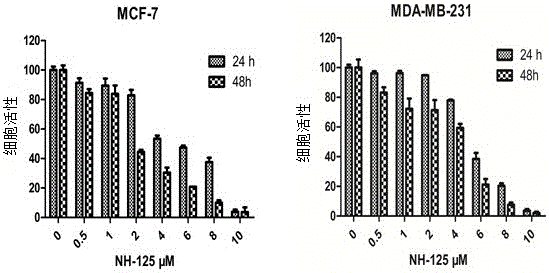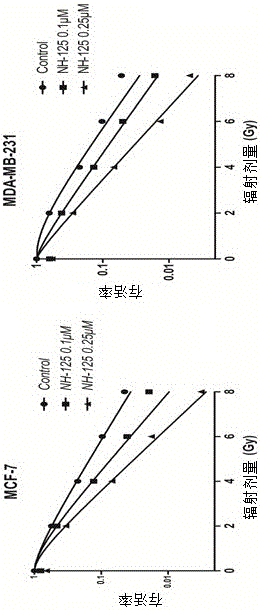Tumor radiosensitizer containing eEF2K inhibitor
A tumor radiation and sensitizer technology, applied in the clinical field, can solve the problems of increasing the efficacy of cancer radiotherapy, target-specific toxicity, low radiation dose, etc., and achieve the effect of reducing complications, reducing impact, and low radiation dose.
- Summary
- Abstract
- Description
- Claims
- Application Information
AI Technical Summary
Problems solved by technology
Method used
Image
Examples
Embodiment 1W
[0024] Example 1 WesternBlot detects the effect of NH-125 on breast cancer cell eEF2K targeting inhibition
[0025] Two types of breast cancer cells MCF-7 and MDA-MB-231 were pretreated with different concentrations of NH-125 for 24 hours and then lysed with RIPA containing 10% PMSF, shaken on ice for 15 minutes, collected, centrifuged at 12,000 rpm for 15 minutes, protein BCA After the kit is quantified, add 5X loadingbuffer and cook for 5 minutes to denature. Electrophoresis with 10% SDS-PAGE gel at 80V for one hour, then switch to 120V for another hour, PVDF membrane 250mA for 100 minutes, 5% milk blocking for 1 hour, primary antibody 4℃ incubation overnight, TBST wash 3 times, 15 minutes each time Incubate the secondary antibody for 1 hour, wash three times with TBST, 15 minutes each time, and develop exposure.
[0026] The result is figure 1 Shown from figure 1 It can be seen that as the concentration of NH125 increases, eEF2K expression is significantly inhibited.
Embodiment 2C
[0027] Example 2 CCK8 experiment to detect the effect of NH-125 on breast cancer cell proliferation:
[0028] Breast cancer cells MCF-7 and MDA-MB-231 were evenly spread in a 96-well plate overnight at a density of 5000 cells / well. The next day, they were treated with different concentrations of NH-125 for 24h and 48h, and then 10% was added to each well. Incubate in CCK at 837°C for 1.5h, then measure the OD value with a spectrophotometer at 450nm wavelength to calculate the cell proliferation.
[0029] The result is figure 2 Shown from figure 2 It can be seen that as the dose of NH-125 increases, cell viability decreases significantly.
Embodiment 3
[0030] Example 3 The clone formation experiment detects the effect of NH-125 on the sensitivity of breast cancer cells to radiotherapy:
[0031] Breast cancer cells MCF-7 and MDA-MB-231 were planted in six-well plates at different densities. After the cells adhered to the wall, they were treated with 0.1 μM and 0.25 μM for 24 hours and DMSO was used as a control. Then the cells were irradiated with 6MV X-ray at a dose rate of 4.5Gy per minute for 0, 2, 4, 6, 8Gy, and then the cells were cultured for two weeks, then methanol fixed for 30 minutes, washed three times in running water and stained with Giemsa stain For 30 minutes, count the number of clones with more than 50 cells.
[0032] Table 1 The effect of NH-125 on the radiosensitivity of breast cancer cells MCF-7
[0033]
[0034] Table 2 The effect of NH-125 on the radiosensitivity of breast cancer cells MDA-MB-231
[0035] The result is image 3 , Table 1 and Table 2, from image 3 It can be seen from Table 1 and Table 2 that wi...
PUM
 Login to View More
Login to View More Abstract
Description
Claims
Application Information
 Login to View More
Login to View More - R&D
- Intellectual Property
- Life Sciences
- Materials
- Tech Scout
- Unparalleled Data Quality
- Higher Quality Content
- 60% Fewer Hallucinations
Browse by: Latest US Patents, China's latest patents, Technical Efficacy Thesaurus, Application Domain, Technology Topic, Popular Technical Reports.
© 2025 PatSnap. All rights reserved.Legal|Privacy policy|Modern Slavery Act Transparency Statement|Sitemap|About US| Contact US: help@patsnap.com



